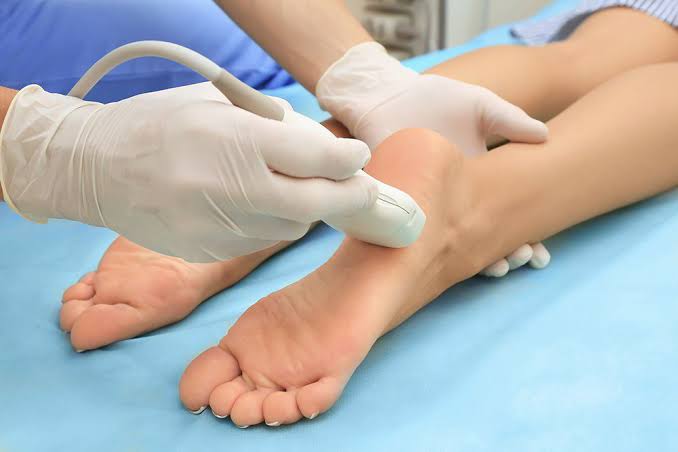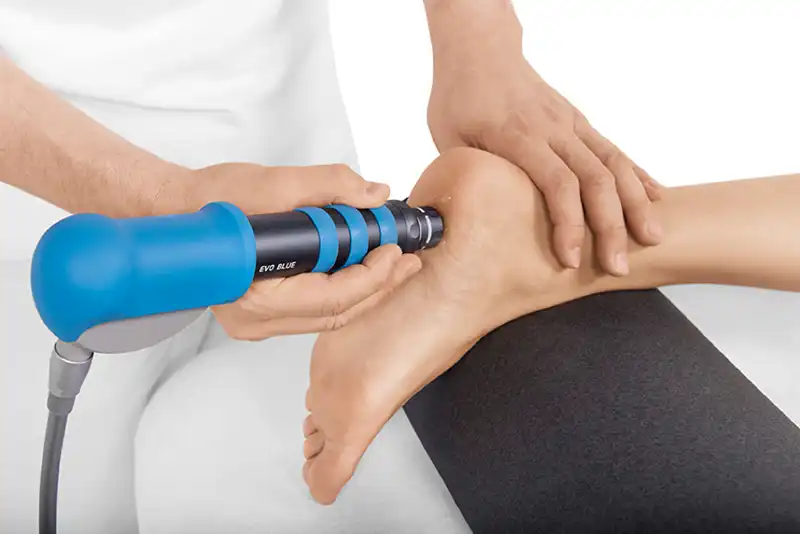Shockwave Therapy
A new non-invasive and cutting edge treatment for a number of problems.



Shockwave Therapy
Shockwave is a new piece of effective, non-invasive and cutting-edge technology that can treat a number of painful problems and injuries. The name might sound a little intense, but don’t worry, there’s nothing to be afraid of.
How Does Shockwave Therapy Work?
It’s a form of treatment that uses high-energy acoustic waves (otherwise known as radial pressure waves) on your injured tissues. It emits the waveforms through the use of a handpiece, which facilitates a local reaction to engage your body’s healing and repair response. This results in an optimal cellular healing environment, which:
Reduces pain
Shock wave therapy can target specific pain in the soft tissues like muscles, ligaments, tendons, joints and bones. To put it simply, the shockwaves will create micro ruptures which stimulate blood flow to the problematic area which will result in localised inflammation.
Following this, your body will naturally work to heal this inflammation, produce new healthy cells – and work to repair damaged cells. Following this, the injured tissues will begin to repair and associated pain will be reduced.
Shock wave therapy can also be helpful with pain relief by helping to release trigger points. We’ll touch more on this below.
Resets the inflammation cycle, which kickstarts chronic non-healing tissues into the reparative stage
As mentioned above, shock wave therapy will cause inflammation and your body will naturally react by trying to repair the affected cells. This encourages non-healing tissues to repair themselves.
Stimulates collagen production to help muscles, tendons and soft tissue repair
When cells are damaged, collagen is naturally produced to try and repair these damaged cells. The older you are, the less your body naturally produces collagen. So, shock wave therapy can be a way to kickstart the body into creating collagen by way of pro-collagen synthesis. Between 1–10% of muscle tissue is composed of collagen and the protein keeps muscles healthy and functioning properly.
Promotes new blood vessel formation
Adequate blood flow it vital in repairing and maintaining damaged tissues. The capillary micro ruptures from shock wave therapy encourage blood vessels to grow in the treated area. These new blood vessels will help to provide the necessary amount of blood to the area, and the increase in oxygen will help to heal tissues faster.
Breaks down calcium build-ups in chronically injured tissues
There has been a range of clinical studies that have proven that shockwave therapy breaks down calcium build up. The acoustic waves that are sent through shockwave therapy work to break up these existing calcifications – or calcium build ups.
Releases trigger points
Shockwave therapy works to gradually release trigger points in the muscles. Trigger points are one of the primary causes of muscle pain and tightness. The acoustic waves sent through shockwave therapy work to unblock the calcium pump and release the trigger points, often resulting in pain relief.
What can Shockwave Therapy treat?
Typically, the best results for Shockwave are found when treating tendon and muscle issues, particularly chronic conditions – those that have been hanging around for a long period of time.
However, we will first need to diagnose your condition and work out if Shockwave is an indicated treatment pathway for you.
Generally, Shockwave can be beneficial for any of the following conditions:
- Plantar fasciitis
- Shin splints
- Achilles tendinopathy
- Other tendinopathies
- Iliotibial band syndrome
- Some chronic long-standing bursitis
- Trigger point therapy
To ensure you achieve a complete recovery and can return to activity, we tend to approach problems in a wholistic nature. Hence, we often use this treatment in conjunction with our range of other treatment options such as orthotic therapy, exercise prescription, mobilisation techniques, dry needling, gait re-training, foot mobilisation therapy, and the list goes on.
What should I expect in a Shockwave treatment session?
We require an initial appointment to assess your problem and determine if Shockwave is going to be an effective treatment pathway for you. If so, it can be administered at the initial consult. Our practitioners are equipped with a diagnostic ultrasound to ensure it is safe to proceed with the treatment and will formulate a treatment plan based on your goals and timeline.
In each of your Shockwave treatments, your podiatrist will follow a similar routine as outlined in the steps below, after your current progress is discussed and other modalities e.g. dry needling and exercise rehab prescription have been performed.
The Benefits of Shockwave Therapy:
- No Medication Needed
- Quick and Efficient
- Accelerated Healing
- Cost Effective
- Less Device
Book an Appointment with Us
View our profile on Healthengine.com.au
General Questions
Here you may find answers to questions some of our clients have asked before? If you have additional questions, don’t hesitate to reach out to us, we’ll be glad to assist.
A typical session lasts about 5 to 10 minutes, depending on the condition being treated. The number of sessions varies, but most treatment plans involve 3 to 5 sessions spaced over several weeks.
Side effects are generally minimal but can include temporary swelling, redness, or bruising at the treatment site. Major complications are rare when the therapy is performed by a qualified professional.
Some patients experience immediate pain relief, while others may notice improvement after a few sessions. The effects of shockwave therapy are cumulative, with optimal results often seen a few weeks after completing the full course of treatment.
Patients are generally advised to reduce physical activity involving the treated area for about 48 hours following each session to maximize the healing process.
